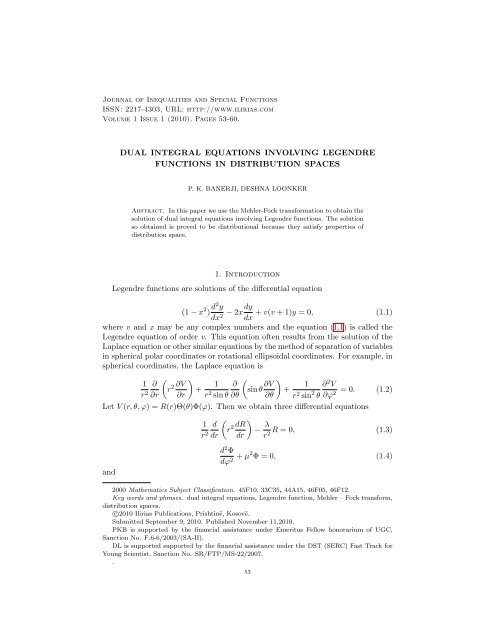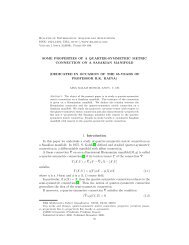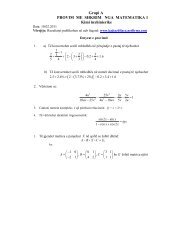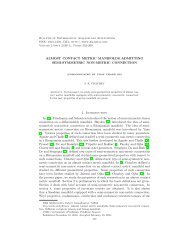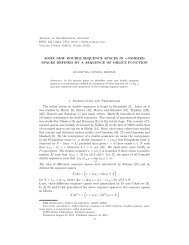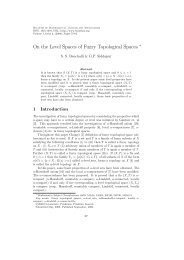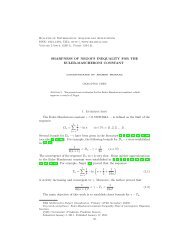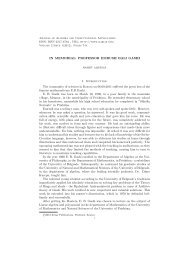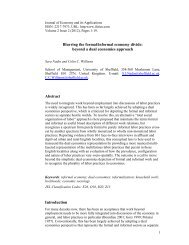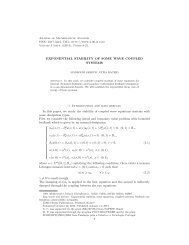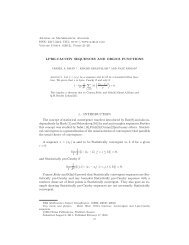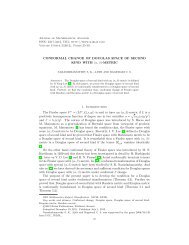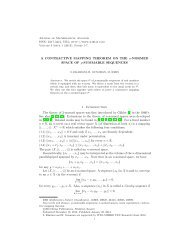DUAL INTEGRAL EQUATIONS INVOLVING LEGENDRE ...
DUAL INTEGRAL EQUATIONS INVOLVING LEGENDRE ...
DUAL INTEGRAL EQUATIONS INVOLVING LEGENDRE ...
Create successful ePaper yourself
Turn your PDF publications into a flip-book with our unique Google optimized e-Paper software.
Journal of Inequalities and Special Functions<br />
ISSN: 2217-4303, URL: http://www.ilirias.com<br />
Volume 1 Issue 1 (2010), Pages 53-60.<br />
<strong>DUAL</strong> <strong>INTEGRAL</strong> <strong>EQUATIONS</strong> <strong>INVOLVING</strong> <strong>LEGENDRE</strong><br />
FUNCTIONS IN DISTRIBUTION SPACES<br />
P. K. BANERJI, DESHNA LOONKER<br />
Abstract. In this paper we use the Mehler-Fock transformation to obtain the<br />
solution of dual integral equations involving Legendre functions. The solution<br />
so obtained is proved to be distributional because they satisfy properties of<br />
distribution space.<br />
1. Introduction<br />
Legendre functions are solutions of the differential equation<br />
(1 − x 2 ) d2 y dy<br />
− 2x + v(v + 1)y = 0, (1.1)<br />
dx2 dx<br />
where v and x may be any complex numbers and the equation (1.1) is called the<br />
Legendre equation of order v. This equation often results from the solution of the<br />
Laplace equation or other similar equations by the method of separation of variables<br />
in spherical polar coordinates or rotational ellipsoidal coordinates. For example, in<br />
spherical coordinates, the Laplace equation is<br />
(<br />
∂<br />
r 2 ∂V )<br />
+<br />
∂r ∂r<br />
(<br />
∂<br />
sin θ ∂V )<br />
+<br />
∂θ ∂θ<br />
1<br />
r 2<br />
1<br />
r 2 sin θ<br />
1<br />
r 2 sin 2 θ<br />
Let V (r, θ, ϕ) = R(r)Θ(θ)Φ(ϕ). Then we obtain three differential equations<br />
and<br />
∂ 2 V<br />
= 0. (1.2)<br />
∂ϕ2 (<br />
1 d<br />
r 2 r 2 dR )<br />
− λ R = 0, (1.3)<br />
dr dr r2 d 2 Φ<br />
dϕ 2 + µ2 Φ = 0, (1.4)<br />
2000 Mathematics Subject Classification. 45F10, 33C35, 44A15, 46F05, 46F12.<br />
Key words and phrases. dual integral equations, Legendre function, Mehler – Fock transform,<br />
distribution spaces.<br />
c○2010 Ilirias Publications, Prishtinë, Kosovë.<br />
Submitted September 9, 2010. Published November 11,2010.<br />
PKB is supported by the financial assistance under Emeritus Fellow honorarium of UGC,<br />
Sanction No. F.6-6/2003/(SA-II).<br />
DL is supported supported by the financial assistance under the DST (SERC) Fast Track for<br />
Young Scientist, Sanction No. SR/FTP/MS-22/2007.<br />
.<br />
53
54 P. K. BANERJI, DESHNA LOONKER<br />
(<br />
1 d<br />
sin θ dΘ ) (<br />
+ λ − µ<br />
sin θ dθ dθ<br />
)<br />
Θ = 0, (1.5)<br />
sin 2 θ<br />
where λ and µ are parameters introduced during the process of separation of variables.<br />
In equation (1.5), putting x = cos θ, y(x) = Θ(θ)and writing v(v + 1) for λ,<br />
we get<br />
[<br />
d<br />
(1 − x 2 ) dy ]<br />
]<br />
+<br />
[v(v + 1) − µ2<br />
dx dx<br />
1 − x 2 y = 0. (1.6)<br />
This is called the associated Legendre equation. Equation (1.1) is its particular<br />
case for µ = 0.<br />
Legendre polynomials are the polynomial solutions of the equations (1.1), where<br />
v = 0, 1, 2, . . .. By the method of solution in series, we may assume, at the ordinary<br />
point [8, p.48] of (1.1), the solution to be<br />
y =<br />
∞∑<br />
a k z k . (1.7)<br />
k=0<br />
The two linearly independent solutions of (1.1), in the ascending powers of x, are<br />
and<br />
y 1 = a 02 F 1<br />
(<br />
− v 2 , v + 1<br />
2 ; 1 2 ; x2 )<br />
(1.8)<br />
y 2 = a 1 x 2 F 1<br />
( 1 − v<br />
2 , 2 + v<br />
2 ; 3 2 ; x2 )<br />
, (1.9)<br />
where 2 F 1 (α, β; γ; x) is the Gauss hypergeometric function. The polynomials thus<br />
obtained are called Legendre polynomials denoted by P v (x)and defined by<br />
P v (x) =<br />
(2v)! (<br />
2 v (v!) 2 xv 2F 1 − v 2 , 1 − v<br />
2 ; 1 )<br />
2 − v; x−2 , (1.10)<br />
where [ ]<br />
v<br />
2 =<br />
v<br />
(v−1)<br />
2<br />
, when v is an even integer and<br />
2<br />
, when is v odd. Legendre<br />
polynomials are particular cases of a more extensive class of functions known as<br />
Legendre functions [9, p.306].<br />
The classical Mehler – Fock transform has been applied to problems in various<br />
mathematical theories, a generalization of which has been given by [1]<br />
∫ ∞<br />
F (r) = f(x)P m,n<br />
0<br />
− 1 x) sinh xdx, (1.11)<br />
2<br />
+ir(cosh<br />
where P m,n<br />
− 1 x) is the generalized Legendre function, which for complex values<br />
of parameters k, mand n , is defined<br />
2<br />
+ir(cosh<br />
by<br />
P m,n<br />
k<br />
(z) =<br />
(z + 1) n/2 [<br />
Γ(1 − m)(z − 1) m/2 2 F 1 k + n − m<br />
2<br />
+ 1, −k + n − m ; 1 − m; 1 − z<br />
2<br />
2<br />
(1.12)<br />
for complex z not lying on the cross-cut along the real x-axis from 1 to −∞. The<br />
corresponding inversion formula is<br />
]<br />
,
<strong>DUAL</strong> <strong>INTEGRAL</strong> <strong>EQUATIONS</strong> IN DISTRIBUTION SPACES 55<br />
∫ ∞<br />
f(x) = χ(r)P m,n<br />
0<br />
− 1 x)F (r)dr,<br />
2<br />
+ir(cosh<br />
where<br />
( ) ( ) ( )<br />
1 − m + n 1 − m + n 1 − m − n<br />
χ(r) = Γ<br />
+ ir Γ<br />
− ir Γ<br />
+ ir<br />
2<br />
2<br />
2<br />
( 1 − m − n [Γ(2ir)Γ(−2ir)π2<br />
n−m+2<br />
×Γ<br />
− ir) ] −1<br />
. (1.13)<br />
2<br />
Equation (1.11), when m = n, reduces to the generalized Mehler-Fock transform,<br />
when m = n = 0, it reduces to classical Mehler-Fock transform [7, p. 390]<br />
inversion of which is<br />
F (r) =<br />
∫ ∞<br />
∫ ∞<br />
0<br />
P 1 α) sinh α f(α)dα, (1.14)<br />
−<br />
2<br />
+ir(cosh<br />
f(α) =<br />
0<br />
r tanh(π r )P 1 α)F (r)dr −<br />
2<br />
+ir(cosh<br />
, (1.15)<br />
see also [6, pp.343-44]<br />
The Parseval relation for the Mehler-Fock transform [7, pp.393-94] is<br />
∫ ∞<br />
0<br />
r tanh(π r)F (r)G(r)dr =<br />
∫ ∞<br />
1<br />
f(x)g(x)dx. (1.16)<br />
Let I denote the open interval (0, ∞). For real numbers α ≥ Re(m) and β ≤ 1/2,<br />
let ς be a continuous positive function on I such that<br />
{ O(t<br />
ς(t) = ς α,β (t) =<br />
α ) , t → 0<br />
O(e βt ) , t → ∞ . (1.17)<br />
Let M α β<br />
(I) is the collection of all infinitely differentiable complex valued function<br />
ϕ defined on an open interval I such that for every non-negative integer k,<br />
γ k (ϕ) = sup<br />
∣ ς(t)∇<br />
k<br />
t ϕ(t) ∣ < ∞, (1.18)<br />
0
56 P. K. BANERJI, DESHNA LOONKER<br />
lim<br />
N→∞<br />
〈 ∫ N<br />
0<br />
χ(r)F (r)P m,n<br />
− 1 2 +ir(cosh t) sinh tdr, ϕ(t) 〉<br />
= 〈f(t), ϕ(t)〉 . (1.21)<br />
One of the properties of the function P − 1<br />
2 +ir (cosh α) is, see [7, p.381],<br />
√<br />
2<br />
P 1 −<br />
2 +ir(cosh α) = π<br />
and similarly, it can be shown that<br />
∫ α<br />
0<br />
cos(τ t)dt<br />
√<br />
cosh α − cosh t<br />
(1.22)<br />
√ ∫ 2<br />
∞<br />
P 1 −<br />
2 +ir(cosh α) = π coth(π τ) sin(τ t)dt<br />
√ (1.23)<br />
α cosh t − cosh α<br />
If the right side of (1.22) is written as<br />
[<br />
]<br />
1 H(α − t)<br />
F c √ √ ; t → τ ,<br />
π (cosh α − cosh t)<br />
where H(·)is the Heaviside function, and F c denote the Fourier cosine transform,<br />
respectively. Now, on applying the Fourier cosine inversion theorem, we observe<br />
F c [P 1 −<br />
2 +ir(cosh α); τ → t] = H(α − t)<br />
√ , (1.24)<br />
π(cosh α − cosh t)<br />
which can be written as<br />
P 1<br />
2<br />
∫ ∞<br />
P 1 −<br />
0 2 +ir(cosh α)(cos τ t)dτ = H(α − t)<br />
√ . (1.25)<br />
2(cosh α − cosh t)<br />
If we regard (1.22) as an integral equation for the function cos(τ t), in terms of<br />
α), then we obtain [7, p. 159]<br />
+ir(cosh<br />
(cos τ t) = 1 √<br />
2<br />
d<br />
dt<br />
∫ t<br />
Similarly, from (1.23) we deduce that<br />
∫ ∞<br />
0<br />
0<br />
P 1 −<br />
2 +ir(cosh α) sinh α dt<br />
√ . (1.26)<br />
(cosh α − cosh t)<br />
tanh(t τ)P 1 −<br />
2 +ir(cosh α)(sin τ t)dτ = H(t − α)<br />
√ . (1.27)<br />
2(cosh t − cosh α)<br />
One requires several spaces of generalized functions to study distributional solutions<br />
of functional equations. Notations of some of these spaces, which appear<br />
frequently, are explained. We consider an interval (a, b), −∞ ≤ a < b ≤ +∞.<br />
The first space is D(a, b) of smooth functions which vanishes outside some compact<br />
subset of (a, b). The space of Schwartz distributions over (a, b) is D ′ (a, b), the dual<br />
of the space D(a, b). If f ∈ D ′ (a, b) and ϕ ∈ D(a, b), then the evaluation of f on ϕ<br />
is denoted as 〈f, ϕ〉.<br />
The space E(a, b)is the space of smooth functions on(a, b), without any restriction<br />
about their support. The dual space E ′ (a, b)is called the space of distributions with<br />
compact support over (a, b). The space E[a, b] is the set of smooth functions in<br />
[a, b]. A family of seminorms, introduced in this space, make it a Fréchet space [3,<br />
p. 177], and its dual E ′ [a, b] is the set of distributions over [a, b], see further details<br />
in [3, pp. 178-79].
<strong>DUAL</strong> <strong>INTEGRAL</strong> <strong>EQUATIONS</strong> IN DISTRIBUTION SPACES 57<br />
There are spaces of mixed type that satisfy one condition at the one end point<br />
but a different condition at the other end point, which (the mixed type spaces)<br />
are required because the behaviour of integral equations at both the end points is<br />
not necessarily the same. D jk (a, b)denote the space of smooth functions on (a, b),<br />
which satisfy the condition j at x = aand the condition k at x = b. D<br />
jk ′ (a, b) is the<br />
dual of it. When j = 4 (k < 4), the support of the elements of D<br />
4k ′ (a, b)is a subset<br />
of [a, b)and, consequently, the notation D<br />
4k ′ [a, b) is used . Similarly, when j < 4,<br />
the notation D<br />
jk ′ [a, b)is used.<br />
Abel’s equation<br />
∫ s<br />
g(t)<br />
f(s) =<br />
dt, 0 < α < 1, (1.28)<br />
a (s − t)<br />
α<br />
is one of the simplest singular integral equations, which is a special case of the<br />
singular integral equation<br />
f(s) =<br />
∫ s<br />
a<br />
g(t)<br />
[h(s) − h(t)] α , 0 < α < 1 (1.29)<br />
where h(s) is a strictly increasing differentiable function with non-zero derivative<br />
over some interval a ≤ s ≤ b, and 0 < α < 1. Solution of this equation is obtained<br />
as<br />
g(t) =<br />
sin απ<br />
π<br />
∫<br />
d s<br />
dt a<br />
h ′ (s)f(s)ds<br />
. (1.30)<br />
(h(t) − h(s))<br />
1−α<br />
Let h is a strictly increasing smooth function and with h ′ > 0, which transmits<br />
[a, b)to the interval [c, d), and b or d, or both can be +∞. If f is a distribution of<br />
the space D ′ 41[c, d), then we define the distribution<br />
T h (f) = T h {f(x); t} = f(h(t))<br />
of the space D ′ 41[a, b), for ϕ ∈ D 41 [a, b), by<br />
〈<br />
〉<br />
〈T h {f(x); t}, ϕ(t)〉 = f(x), ϕ(h−1 (x))<br />
h ′ (h −1 , (1.31)<br />
(x))<br />
One may, for the Mehler-Fock transformation and its inverse for the tempered<br />
distribution, see [4] and for further extension of the present work, see [5], to ultradistribution.<br />
In Section 2 we obtain the distributional solution of certain type of<br />
dual integral equations, with associated Legendre function as kernel.<br />
2. Distributional Solution of Dual Integral Equations<br />
In this section we obtain the distributional solution of certain dual integral equations<br />
[7, p. 407]<br />
and<br />
g(α) =<br />
∫ ∞<br />
0<br />
f(τ)P −<br />
1<br />
2 +iτ (cosh α)dτ = g 1(α); 0 ≤ α ≤ α 1 , (2.1)
58 P. K. BANERJI, DESHNA LOONKER<br />
∫ ∞<br />
h(α) = τ tanh(π τ)f(τ)P 1 (cosh α)dτ = h −<br />
2(α); α > α 1 . (2.2)<br />
0<br />
2 +iτ<br />
where α 1 is an arbitrary positive number. By virtue of the validity of embedding<br />
from the linear spaces into their duals [2, pp. 121-23], for the distribution spaces,<br />
considered in this paper, the imbeddings are D → M α β<br />
(I) → S → E and their duals<br />
E ′ → S ′ → M ′ β α → D ′ for the generalized Mehler-Fock transform of order zero.<br />
The equation (1.31) is obtained due to the property<br />
∫ b<br />
∫ d<br />
f(h(t))ϕ(t)dt = f(x) ϕ(h−1 (x))<br />
a<br />
c h ′ (h −1 dx, (2.3)<br />
(x))<br />
where f is locally integrable on [a, b). If x 0 ∈ [c, d), then<br />
T h {δ(x − x 0 ); t} = δ(h(t) − x 0 ) = δ(t − h−1 (x 0 ))<br />
h ′ (h −1 (x 0 )) . (2.4)<br />
The operator T h −1 : D 41[a, ′ b) → D 41[c, ′ d)is defined by<br />
(T h ) −1 = T h −1. (2.5)<br />
The distributional interpretation of (1.28), in terms of T h and T h −1, is, see [3, p.<br />
188],<br />
[ ( g<br />
)]<br />
f = T h x −α<br />
+ ∗ T h −1<br />
h ′ , (2.6)<br />
and the solution for (1.28) is<br />
sin απ d<br />
g(t) =<br />
π dt T (<br />
h x<br />
−α<br />
+ ∗ T h −1(f); t ) , (2.7)<br />
where f is the usual locally integrable function.<br />
We notice [7, pp. 407-408] that the involvement of functions F 1 (x) and F 2 (x)in<br />
terms of the prescribed functions g 1 (α) and h 2 (α) are given by<br />
and<br />
F 1 (x) = √ 1 ∫<br />
d x<br />
g 1 (α) sinh α dα<br />
√ (2.8)<br />
π dx 0 (cosh x − cosh α)<br />
F 2 (x) = √ 1 ∫ ∞<br />
h 2 (α) sinh α dα<br />
√ , x ≥ α 1 (2.9)<br />
π (cosh α − cosh x)<br />
x<br />
The function F 1 (x), that is given by (2.8), is similar to the distributional solution<br />
obtained in (1.30). Further, by considering cosh α as a strictly increasing function,<br />
the function F 1 (x) in (2.8) is similar to the distributional solution given by (2.7).<br />
By virtue of relations (1.28) – (1.31) and (2.3) – (2.7), we justify to state that g 1 (α)<br />
is a locally integrable function and since the properties of the operators cosh α and<br />
cosh x has the correspondence D ′ 41[0, ∞)→ D ′ 41(x, ∞], the function F 1 (x)turns out<br />
to be locally integrable and hence it is, indeed, true that (2.8) is the required distributional<br />
solution. This allow us, simultaneously, to confirm that F 1 (x)is defined<br />
on spaces D ′ , M ′ β α ,E ′ , S ′ , respectively, by considering distributional generalized<br />
Mehler-Fock transform of order zero, i.e. ,
<strong>DUAL</strong> <strong>INTEGRAL</strong> <strong>EQUATIONS</strong> IN DISTRIBUTION SPACES 59<br />
F 0 [H(α − t)(cosh α − cosh t) −1/2 ; α → τ] = √ 2 τ −1 coth(π τ) sin(t τ). (2.10)<br />
Similarly, F 2 (x) is defined on distribution spaces mentioned forF 1 (x) by considering<br />
inversion formula of distributional generalized Mehler-Fock transform of order<br />
zero, given by (1.27). The function F (x)is defined by<br />
F (x) =<br />
{<br />
F1 (x) ; 0 ≤ x ≤ α 1<br />
F 2 (x) ; x > α 1<br />
, (2.11)<br />
We notice that F c [f(τ); x] = F (x), where F c is the Fourier cosine transform and<br />
hence that<br />
f(τ) = F c [F (x); τ]. (2.12)<br />
Thus, the distributional solution of the dual integral equations (2.1) and (2.2) can<br />
be obtained through (2.12), (2.11), (2.8) and (2.9).<br />
On substituting f(τ) from (2.12) into (2.8), we get g(α) = g 2 (α), α > α 1 , where<br />
√<br />
2<br />
g 2 (α) =<br />
π<br />
∫ α1<br />
0<br />
√<br />
F 1 (x)dx 2<br />
√ +<br />
(cosh α − cosh x) π<br />
∫ ∞<br />
α 1<br />
F 2 (x)dx<br />
√<br />
(cosh x − cosh α)<br />
. (2.13)<br />
It can (as above) be shown that if 0 < α < α 1 , then h(α) = h 1 (α), where<br />
h 1 (α) = cosechα √ π<br />
d<br />
dα<br />
∫ α1<br />
α<br />
{F 2 (α 1 ) − F 1 (x)}<br />
√<br />
(cosh x − cosh α)<br />
sinh xdx. (2.14)<br />
Proceeding through similar analysis those employed above to obtain distributional<br />
solution of equations (2.1) and (2.2), we can, indeed show (calculations are<br />
avoided for obvious reasons ) that the pair of dual integral equations<br />
and<br />
g(α) ≡<br />
∫ ∞<br />
0<br />
τ f(τ)P −<br />
1<br />
2 +iτ (cosh α)dτ = g 1(α); 0 ≤ α ≤ α 1 , (2.15)<br />
h(α) ≡<br />
∫ ∞<br />
0<br />
tanh(π τ)f(τ)P −<br />
1<br />
2 +iτ (cosh α)dτ = h 2(α); α > α 1 . (2.16)<br />
have the solution f(τ) = F s [F (x); τ], where F s is the Fourier sine transform, and<br />
F (x) is defined by (2.11). Consequently, we have shown that (2.1) and (2.2) (respectively<br />
(2.15) and (2.16)) have the distributional solutions, f(τ) = F c [F (x); τ]<br />
and f(τ) = F s [F (x); τ], respectively.<br />
Acknowledgment. Authors are thankful to the referee for advising fruitful improvements<br />
in this paper.
60 P. K. BANERJI, DESHNA LOONKER<br />
References<br />
[1] B. L. J. Braaksma and B. Meulenbeld, Integral transforms with generalized Legendre functions<br />
as kernels, Composito Math. 18 3(1967) 235-287.<br />
[2] Yu. A. Brychkov and A. P. Prudnikov, Integral Transforms of Generalized Functions, Gordon<br />
and Breach Science Publishers, New York, London (1992).<br />
[3] R. Estrada and R. P. Kanwal, Singular Integral Equations, Birkhäuser, Boston, Berlin, Basel<br />
(2000).<br />
[4] Deshna Loonker and P. K. Banerji, Mehler-Fock transform of tempered distribution, J. Indian<br />
Acad. Math. 30 1 (2008) 229-235.<br />
[5] Deshna Loonker and P. K. Banerji, Mehler-Fock transformation of ultradistribution, Applications<br />
and Applied Mathematics, 4 1(2009) 237-248.<br />
[6] R. S. Pathak, Integral Transforms of Generalized Functions and their Applications, Gordon<br />
and Breach Science Publ., Canada, Australia, France (1997).<br />
[7] I. N. Sneddon, The Use of Integral Transforms, Tata McGraw-Hill Publ. Co. Ltd., New Delhi<br />
(1974).<br />
[8] Z. X. Wang and D. R. Guo, Special Functions, World Scientific, Singapore, Hongkong (1989).<br />
[9] E. T. Whittaker and G. N. Watson, A Course of Modern Analysis, Cambridge University<br />
Press, Cambridge, Reprint (1962).<br />
P. K. Banerji, Department of Mathematics, Faculty of Science, JNV University,<br />
Jodhpur- 342 005, India<br />
E-mail address: banerjipk@yahoo.com<br />
Deshna Loonker, Department of Mathematics, Faculty of Science, JNV University,<br />
Jodhpur- 342 005, India<br />
E-mail address: deshnap@yahoo.com


